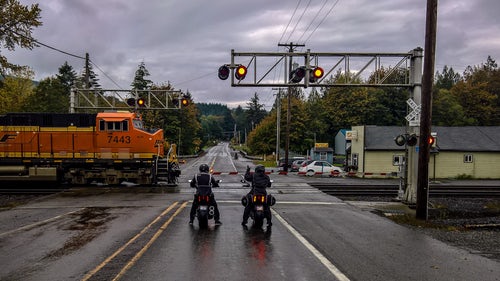WHEN A CAR MEETS A TRAIN the result is usually “train 1, car 0”. Yet it is surprising how few people understand the basic rules to be followed at a level crossing. Even worse, one in four motorists admitted to engaging in risky behaviour at rail crossings (as an aside, this is one case where I agree with our American cousins whose sign reads “Rail Road crossing” rather than our “Railway Crossing” – after all, this is where the road crosses a railway).
Trains travel at high speeds, they weigh a lot and they have considerable inertia. Basic road rules at level crossings are designed to save lives and ignoring them has a huge potential for disaster.
Each year, a substantial number of Australians die because they have taken silly risks at rail crossings. Disturbingly, most incidents are the result of inattention or people simply failing to see the risks in their behaviour.
Some rail crossings in most states are long overdue for upgrades but the statistics show that the vast majority of train/vehicle crashes occur at level crossings controlled by boom gates, flashing lights and audible warnings.
Common sense is the best approach. As you come to a give way or stop sign at a rail crossing, don’t assume there won’t be a train; assume there will be. Slow down and be prepared to come to a complete stop.
As usual, there is a woeful lack of knowledge of the road rules at level crossings. It is illegal for a motorist or pedestrian to enter a level crossing if warning lights or bells are operating (even if no train or tram is visible); if a boom gate or barrier is down or in the process of opening or closing (you stop if it is descending, and wait until it is fully raised before continuing on your way); a train or tram can be seen or heard approaching the crossing (even if no physical or audible warning is operating); and vitally, it is illegal to enter a level crossing if there is no safe passage through it and entering the crossing may leave a vehicle stranded on the line.
Pedestrians are reminded that if a pedestrian gate is closed they should not jump the barrier, even if they think there is sufficient time to cross the tracks before the train or tram arrives. In addition, trespassing on railway tracks anywhere other than designated pedestrian crossings is not only stupidly unsafe, it is also illegal.
Modern trains and trams are fast vehicles, and these days often remarkably quiet. Judging their closing speed is difficult and misjudging the distance between yourself and the approaching train or tram can be tricky, especially for older drivers. Err on the side of caution. And just because one train has passed through the level crossing, be aware that another may be close behind or coming from the other direction.
